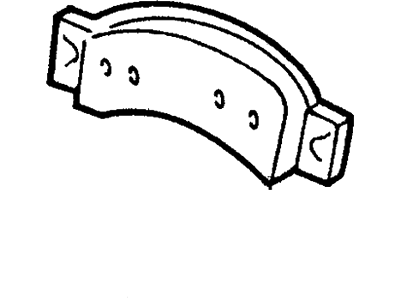

My Garage
My Account
Cart
Genuine Ford Bronco II Brake Pads
Disc Brake Pad Set- Select Vehicle by Model
- Select Vehicle by VIN
Select Vehicle by Model
orMake
Model
Year
Select Vehicle by VIN
For the most accurate results, select vehicle by your VIN (Vehicle Identification Number).
1 Brake Pads found
Ford Bronco II Brake Pads
The Brake Pads are parts of the Ford Bronco II braking system that enables the car to stop by using force through the brake rotors. These pads have a friction material having a metal base plate that transforms kinetic energy to thermal energy through friction. There is wear and tear over a period of operation and the Brake Pads particularly have to be replaced frequently, about 50000 miles on average. Some of the brake pads used on Ford Bronco II vehicle include the non-metallic, the semi metallic, fully metallic and the ceramic type. Both provide different characteristics in a tribosystem including coefficient of friction, wear rate, and noise. Further, while applying Brake Pads, it is common that part of the associated hardware like clips or springs has to be changed to guarantee the optimum functionality and durability of the Brake Pads. Al together Brake Pads in Ford Bronco II cars are crucial to effective and safe braking system.
We provide a wide range of Ford Bronco II Brake Pads at the best prices possible. If you need Ford Bronco II Brake Pads, you can shop with confidence on our website. All our OEM parts come with a manufacturer's warranty and are delivered to your door step with a fast delivery service.
Ford Bronco II Brake Pads Parts Questions & Experts Answers
- Q: What are the inspection and removal procedures for brake pads and calipers on Ford Bronco II?A:Older brake pads or shoes may contain asbestos, a known cancer-causing agent, so it is crucial to avoid cleaning brake surfaces with compressed air and inhaling any dust. When cleaning, use a commercially available brake cleaning fluid. Front pads should be replaced when their thickness reaches the minimum of 1/32 in. (0.8mm) as recommended by Ford or as required by local inspection codes, which can be checked by removing the wheel and inspecting through the caliper assembly. Always replace all disc pad assemblies on an axle and install new caliper pins whenever the caliper is removed. To prevent fluid overflow when pressing the caliper piston, remove or siphon some brake fluid from the master cylinder reservoir. Loosen the wheel lug nuts, raise the vehicle, and secure it with jackstands before removing a front wheel. Use a C-clamp to push the caliper piston back into its bore for easier removal. The removal process for caliper pins varies based on their type; the upper pin should be removed first. If the bolt head is on the outside, tap it from the inner side until a gap appears, then cut off the bolt head and depress the tab while tapping the pin out. If the nut is on the outside, remove it, depress the lead tang, and tap the pin out. Repeat for the lower caliper pin, then remove the caliper from the rotor and the pads. Install the inner pad against the caliper piston, reassemble the C-clamp, and tighten until the piston is fully seated. Place a new anti-rattle clip on the inner pad, position the pads and clip correctly, and install the outer pad ensuring proper seating. Mount the caliper on the spindle, lubricate the grooves, and install new caliper pins with the correct orientation. After securing the caliper, install the wheel and tire assembly, lower the vehicle, and torque the lug nuts. Initially, the brake pedal may feel soft; pump it until it firms up, then check the brake fluid level and ensure proper brake operation before driving.





